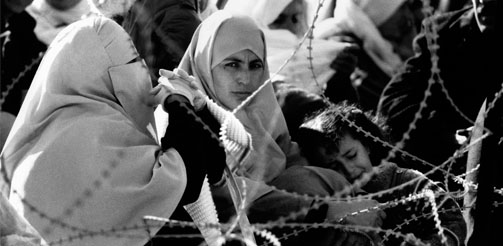Originally published on IDS’s website. Available at: https://www.ids.ac.uk/news/new-ids-research-reveals-impact-of-militarism-on-violence-against-women-in-gaza
This year’s 16 Days Against Gender-based Violence campaign focuses specifically on the relationship between militarism and the right to education. This right to education should include the availability of proper educational infrastructure and facilities as well as safe access. Unfortunately, however, this is not the daily reality of school-aged children everywhere in the world: discrimination, lack of resources and violence is undermining the universal human right to education of millions of girls and boys, and young women and men.

During last year’s Israeli military operation ‘Protective Edge’, the 1.8 million Palestinians in the Gaza Strip were heavily affected by the worst escalation of hostilities in the area, which resulted in the highest civilian death toll since 1967. A total of 2,251 Palestinians, including 1,462 civilians, were killed. Of the Palestinian fatalities, 551 were children and 299 women. The military operations also caused widespread destruction of infrastructure, amongst which twenty-six schools were completely destroyed and 122 schools damaged. As a result, the new school year had to be postponed and the over-crowding and under-resourcing of schools have become even more acute, hampering the access to education to more than half a million children. Furthermore, young survivors have to cope with psychological trauma, which is often linked to loss of concentration at school.
As blockades continue on land, air and sea, families and individuals of Gaza face increasing socioeconomic pressures. Together with repeated outbreaks of hostilities and escalating violence, these have enormous negative impacts on access to key services, well-being and social relations.
Revealing the links between peace in the home and peace in the world
Directly following the last Israeli military operation in summer 2014, UNFPA investigated the lives of internally displaced women and girls in Gaza, highlighting that many women and girls were subject to various types and degrees of violence in emergency shelters and host families’ homes. To complement this study and paint a representative picture of types and prevalence rates of violence experienced by women across Gaza in order to inform services to protect and support women survivors of violence, the Institute of Development Studies (IDS) with ActionAid and Alianza por la Solidaridad conducted an in-depth study on Violence against women in the Gaza Strip after the Israeli military operation ‘Protective Edge’ 2014. Between April and July 2015 37 social workers and field researchers spoke to 332 women, 130 men, 7 key community informants and 28 members of civil society organisations in focus group discussions, roundtables and individual interviews, and carried out a questionnaire survey with 440 women.
The research findings revealed that most of the violence experienced by women is perpetrated by husbands or other family members inside their homes; almost 40 per cent of women interviewed experienced at least one act of domestic violence since the end of the military operation. The study participants established a clear link between occupation violence on the one hand and violence against women on the other hand. They stressed the role played by the deterioration of the economic situation caused by wars with Israel, internal conflicts, the closing of borders and the ongoing siege. Survey data confirmed that heightened levels of stress and depression among men due to the economic situation had a direct effect on women’s exposure to physical domestic violence. According to the survey data, the incidence of physical and verbal abuse experienced by women in private and public spheres was higher in the ten months following the military operation, than during the whole year preceding the operation. The difference is statistically significant. Displacement during the hostilities was also highly correlated with increased odds for women to experience domestic violence perpetrated by husbands or other family members. This is particularly true for emotional and physical domestic violence and controlling behaviors by husbands.
What can be done?
Potential avenues to protect women from domestic violence include: awareness raising and supporting activities with men and women that reach a wider audience, including religious and traditional leaders; reducing rates of early marriage; and strengthened cooperation amongst governmental, non-governmental and international actors. Such cooperation would enable organisations to become more specialised and effective, and would enhance synergies between relief and development programmes, without the need to discontinue one at the expense of the other in times of emergency.
On this year’s International Day of Solidarity with the Palestine People, project researchers urge the international community to take note of the dire consequences of the ongoing conflict and blockades in Gaza on the extent of violence suffered by women and girls, and on their access to health and education. The continuous application of political pressure to bring an end to the ongoing siege and access restrictions will be an essential contribution to the economic recovery of Gaza – relieving individuals, families and communities from some of the daily stresses that are associated with higher levels of domestic violence.
Image: J.C. Tordai / Panos
